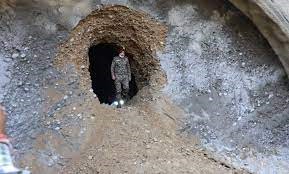Description

Disclaimer: Copyright infringement not intended.
Context
- The Border Roads Organisation last month achieved a breakthrough in a vital tunnel along the 250-km long and strategically important National Highway 144A in Jammu and Kashmir.
- The tunnel forms part of the Rs 5,100-crore NH upgrade project under the Rs 80,068-crore Prime Minister’s Development Package announced in November 2015 as Reconstruction Plan for Jammu and Kashmir.
Details
What is NH 144A and when did it come into existence?
- It is a double-lane road that starts from Jammu and goes up to Rajouri and Poonch districts.
- It provides road connectivity to the Akhnoor sub-division and part of the Reasi district.
- The double-lane road was given the status of a national highway and named NH 144A by the central government in 2015.
What is the significance of its upgradation?
- The National Highway is being upgraded from the existing two lanes to four lanes, so as to provide better, speedy, and all-weather road connectivity to people living in the border districts of Rajouri and Poonch and a part of both the Jammu and Reasi districts.
- The project is expected to result in socio-economic growth of parts of Jammu and Reasi districts, besides the Pir Panjal region comprising the twin border districts of Rajouri and Poonch.
- It will cut the travel time between Poonch-Rajouri and Jammu from the present 6-7 hours to 4.5 hours.
- This strategically important highway will also lead to speedy movement of defense vehicles to areas along the Line of Control right from the Chicken Neck in Akhnoor subdivision up to Poonch district adjoining Kashmir Valley at all times, including war.
- The need to upgrade the Jammu-Akhnoor stretch into a four-lane highway and then it's widening with paved shoulder from Akhnoor to Poonch was felt in view of the voluminous increase in vehicular traffic and frequent road accidents.
- Moreover, road widening has been a long-pending demand of locals as well.
Who is executing this project?
- While the four-laning of the highway from Jammu to Akhnoor is being executed by the National Highway and Infrastructure Development Corporation Limited (NHIDCL), the remaining work from Akhnoor to Poonch has been undertaken by the Border Roads Organisation under its Project Sampark.
- The Ministry of Road Transport and Highways has set March 2025 as the target for the four-laning of the highway between Jammu and Akhnoor, including the construction of a 4.6-km flyover between Jammu city’s Canal Head to Muthi.
- However, most of the work on this stretch is complete and the flyover is also thrown open for vehicular traffic.

What about the Akhnoor to Poonch stretch?
- The road-widening work on the remaining 200 km stretch from Akhnoor to Rajouri, and then onward to Poonch, is being undertaken by the BRO under Project Sampark.
- As this stretch of highway passes through the Pir Panjal mountainous region and has sharp curves, it will have four tunnels, reducing the road length by 32 km and the travel time to 4.5 hours.
- To complete the project, BRO has divided it into eight packages including four single-tube tunnels, reducing the road gradients and sharp curves on mountainous terrain.
- Package 1: It starts from Akhnoor and ends at Chowki Choura passing through Tanda. A 260-mts Kandi tunnel falls en route, in which BRO had made a breakthrough last month.
- Package 2: Passing through village Sungal where a 2.78 km tunnel is being dug by BRO bypassing Kalidhar village, this road stretch begins from Chowki Choura and ends near Bhamla.
- The work on the Sungal tunnel is in progress from both ends and it is likely to be completed by August 2024.
- Package 3: Starting from Bhamla to Bakhar with a 4-km bypass, this road stretch will bypass Sunderbani town.
- Package-4: It will start from Bakhar and end near Nowshera, passing through Thandapani, Siot and Lamberi.
- Package-5: From Nowshera, it will go up to Kallar passing through Narian and Chingus where the remains of the Mughal Emperor Jahangir were buried after he died on way to Lahore from Kashmir on October 29, 1627. This was done on instructions of his queen Nur Jahan to embalm and preserve his body.
- A new bridge will also be constructed, leading to a 0.700 km tunnel bypassing the existing Tain bridge.
- Package-6: Beginning from Kallar, it ends at Dhari Dhara near Manjakote, passing through Muradpur, Rajouri, Thandi Kassi, Gambhir, Rajdhani, and Patrara. It will also have a 2.7-km bypass leaving Manjakote town on a side.
- Package-7: From Dhari Dhara to Bhatadhurian, it includes construction of a 15-km new road and a 1.1-km tunnel at Bhatadhurian, instead of upradation of the existing road between the two places. The new road will pass through Galhoti, Gambhir Mughlan and Sangiot.
- Package-8: It will start from Bhatadurian and end at Poonch Police Lines after passing through Jaran Wali Gali, Potha, Sanai, Lassana, Kalai, Chandak, Dingla, and Nangali. Instead of upgrading the old road from Kalai to Poonch via Bhainch, a new 7.6 km road will be constructed from Kalai to Poonch via Nangali.
|
PRACTICE QUESTION
Examine the significance of National Highways in border areas for a nation's security, economic development, and connectivity. Discuss the challenges associated with building and maintaining these highways in such regions and propose strategies to address them. (250 words)
|














